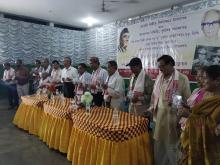“The Assam State Zoo encompassing over 130 hectares of land boasts of an astonishing collection of some rare and extinct species of wild animals settled comfortably in their natural habitat.” This is how a website describes the zoo in our city. However, the ‘stay’ of the animals there is far from ‘comfortable’. The captive animals in small enclosures with hardly room for free movement is a far cry from comfortable.
The Assam state Zoo boasts of white tigers, one horned rhinos, Swamp tapirs and leopards to name a few. The zoo is also prosperous in the avian branch and plays host to rare species of birds. Sadly, the animals are caged for better viewing of tourists.
But I dread to think in what conditions these hapless beings spend their lives unable to soar high in the sky, or even to flap their wings. They have been cursed to resign their freedom and rot in tiny cages all for a few minutes of our momentary delight.
Zoo is an abbreviation of a zoological garden or zoological park. It is an institution in which living animals are exhibited in captivity. In addition to their status as tourist attractions and recreational facilities, modern zoos may engage in captive breeding programs, conservation study, and educational outreach.
How on earth did such a trend of taking four legged prisoners start? It seems collections of wild animals were common in the civilizations of Mesopotamia, Egypt, and China. Later too in medieval Europe the trend of maintaining collections of wild animals continued by certain monarchs, monasteries, and municipalities. The transition from menagerie, a predominantly private collection, to public institution marked the beginning of the modern zoo concept. And the cruel saga is carried forth by modern civilizations till date. Collections established during the nineteenth century began calling themselves zoological gardens. Throughout the nineteenth and twentieth centuries, many new zoos and related facilities were founded for very different motives and purposes.
The aims of zoo professionals have traditionally ranged from public education to conservation of biodiversity, as well as recreation. Many zoos define their aims as education, research, and conservation. The aims are noble there is no doubt about it but they are carried out in an ignoble manner. The living conditions of the animals, their upkeep, medical aid, nutrition etc all have loopholes. Just take a walk around your city zoo and you will know what I mean. Animal-rights groups are crying hoarse that that there is a wide gap between these claimed aims and actual practice, and that zoos have commercial and entertainment purposes in mind as well as financial profit. Zoos are frequently criticized by animal rights groups for varied reasons, including the quality of life of the animals they exhibit, and the perceived necessity or purpose of exhibiting captive animals at all.
The question arises are there any positive aspects of the zoo culture? For the answer we need to spotlight on the life of wild animals living in captivity around the world. The zoos world over has adopted the open zoo concept by exchanging the cage to larger natural enclosures where the animals can feel at home even in captivity. The Chattbir Zoo in Chandigarh, the Toronga Zoo in Sydney, the Bronx zoo in America etc. are some of the perfect examples of this transition, which truly promises a comfortable stay for its four pawed guests.
Such exemplary zoos are an eye-opener for others to follow suit. They present the perfect example of keeping captive wild animals and giving them the best that captivity has to offer. Instead of watching the animals from an entertainment point of view we need to wonder what it must be like for the animals that live day after day in the same enclosures. Should these animals be here at all? Are we doing everything we can to give them a life that lets them behave as they would in the wild?
Not many months ago Guwahati was witness to an innocent zoo visit go horribly wrong when a tiger chopped off a hand of a spectator when he went for a closer look and fatally wounding him. On Christmas Day 2007, a 4-year-old Siberian tiger called Tatiana escaped her enclosure at the San Francisco Zoo, fatally mauling a 17-year-old and injuring two other men.. These stories instantly made international headlines and commentators from all backgrounds took to the airwaves to offer hypotheses of how such dreadful tragedies could have occurred.
Sadly, such accidents are not unexpected at all. In the Guwahati incident the visitor violated repeated warnings of zoo officials. A year prior to the deadly December incident, Tatiana injured a zookeeper at the zoo during a regular publicly viewed feeding.
These are after all wild animals. Should they be forced to small confines day in and day out. Imagine the frustration building up over the years of captivity. Try to gauge the mental state. In short caging wild animals in perpetuity — isolated from their natural habitat, deprived of freedom, and without psychological, environmental, and social enrichment — is inhumane. There is no definite educational benefit in keeping wild animals in captivity, and our collective focus must be the conservation of species in the wild.
In captivity, animals are kept in unnatural surroundings, in artificial physical and (often) social environments with little mental and physical stimulation. What will people learn when they see a wild animal removed from its natural habitat. It will behave abnormally for it is removed from reality.
Not much research has been done so far to see the educational effect of animals in captivity. Visitors hardly spare a glane at the caged animals in a zoo. Perhaps there is some signage on the cage; perhaps it is more than a few bullet points. This is not educational. Zoo visit is simply recreational for visitors and that too a little dubious.
Tons of money can be spent altering enclosures — with little benefit for the animals. But if the money is spent in conservation in the wild places where animals live naturally would reap benefits for years to come. Ten million dollars invested in anti-poaching efforts around Mount Kenya, for instance, could fund vital, life-saving conservation initiatives into the next century! In an American urban zoo that’s maybe a single, modest animal enclosure. Put the money into the wild ... that’s real conservation.
A World Heritage Site, Kaziranga, whose area was increased from 430 sq km to 890 sq km eight years ago, currently has 435 guards to protect 1,800-odd rhinos, 86 tigers and hundreds of other species. Yet the increased rate of poaching incidents of one-horned rhinos could not be curbed. Many times the government has acknowledged its failure to provide enough manpower to protect the animals. The need of the hour is to provide adequate manpower and round the clock video surveillance if we seriously want to bring down poaching.
Our system of governance simply distributes portfolios to ministers at random without considering the qualifications or suitability of the men with their posts. For instance it should be a pre requisite for a forest minister to be compassionate toward animals or he or she should be a wildlife or animal activist. Then only then can we provide a safe and comfortable environment to the animals in the wild or otherwise. Similar should be the case with forest guards who are responsible for the safety and protection of the animals.
When we are unable to apprehend a handful of poachers in a given area such as the Kaziranga National Park we should simply forget about hopes of curbing terrorism.
Born Free USA united with API has urged a detailed federal examination of animal welfare and public safety conditions at all American zoos. They have made arrangements with their governments urging for an in-depth exami
nation of current oversight of their zoos, with the ultimate goal of determining what specific immediate and long-term steps need to be taken to ensure the highest standards of animal welfare and to prevent another harmful human/animal interaction from ever occurring again.
We Indians too should follow suit. There should be a thorough examination of the zoos to determine which facilities should be closed down immediately based on substandard animal welfare conditions and/or heightened risk to human visitors.
Ironically, wild tigers are rapidly disappearing from the planet. A century ago as many as 100,000 wild tigers roamed across their natural range. Now, an estimated 3,000 cling perilously to existence. Sadly there are more tigers held in private hands in America or tiger factories in China than are living freely in the wild.
Assam is rich in its flora and fauna. It has numerous wild life parks such as Manas National Park, the only tiger Project in Assam. It is also a well-known heritage site. Pobitora Wildlife Sanctuary is major wildlife stock, situated in Morigaon district of Assam, the northeastern state of India. Covering an area of 38.8 Sq. km., the Pobitora Wildlife Sanctuary is about 50 km from Guwahati situated on the border of Nagaon and Kamrup Dist. It is mainly famous for its great Indian one horned Rhinoceros. Besides Rhinoceros the other animals are Asiatic Buffalo, Leopard, Wild bear, civet cat etc. Assam Pobitora Wildlife Sanctuary is also home to more than 2000 migratory birds and various reptiles.
Conservation group Aaranyak under the aegis of the Assam Forest and Wildlife Department, has indicated that a sizeable tiger population has survived in the sprawling wildlife sanctuary of Kaziranga.
The deaths of ten tigers in Kaziranga sometime back had set alarm bells ringing among the authorities. But a survey by Aranyak indicated that there is one tiger per 100 sq km in the wildlife park, which has been declared a world heritage site by UNESCO, due to the large population of endangered one-horned rhinoceros. Once selected as one of the seven new wonders of the world the places will gain immense and immediate popularity. If KNP is the lucky few it would not only boost tourism but it would be a great blessing to the animals inhabiting it. The world attention will surely bring in some good measures to improve the quality of their lives.
The citizen can do a lot in bringing justice to animals in captivity. Let us wake up towards an improved condition for animals who are presently languishing desperately on cement and behind bars. Save them they need your help.
The media which is a mirror of society has been broken into shards by the the guns of millitants in Manipur. The newspapers were missing from their usual stands in Manipur following threats and counter threats by rival factions of rebel organisation PREPAK over publication of a statement. According to the All Manipur Working Journalists Union the media was torn over a decision to publish a statement which a faction of the PREPAK wanted to publish while another opposed and threatened to react violently if published.The journalists fearing for their lives sought safety in the Imphal Press clubs instead of their homes for fear of persecution. But this is not unusual in manipur as earlier also...






Comments
Pages
Add new comment